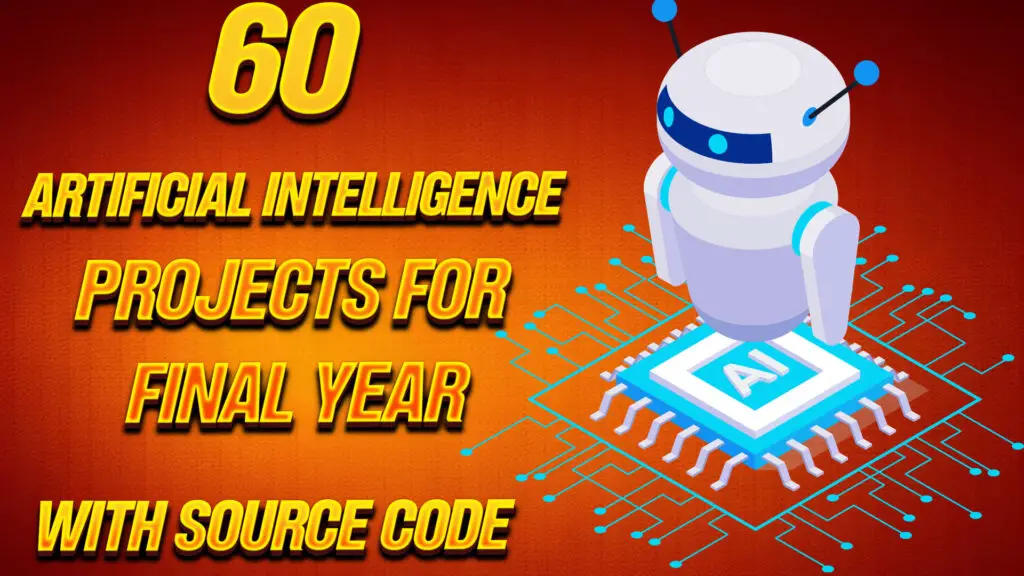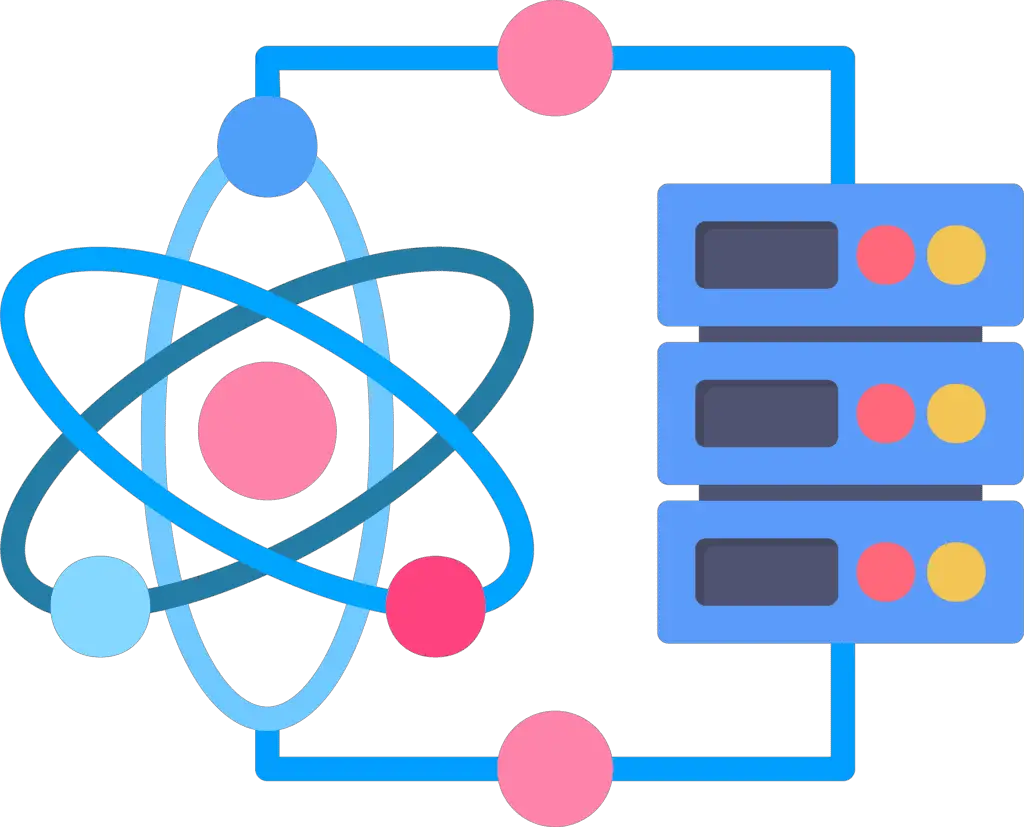Best 60 artificial intelligence projects for final year

Selecting an AI project for the final year is an excellent opportunity to showcase your skills and boost your grades. Artificial intelligence has a profound impact on various industries, to such an extent that an artificial intelligence project has the potential to bring about significant changes. This article will give you 60 unique Artificial intelligence final year project ideas. To help you source code is also there with every project.
1. Bitcoin Price Prediction Using Machine Learning
Introduction: Bitcoin is a decentralized digital money uncontrolled by any financial organization or government and uses data encryption for protection. Nowadays, demand for bitcoin also increases day by day because the price of bitcoin is currently high. So, building a Bitcoin price prediction is an AI-based system that predicts the future value of Bitcoin. It uses machine learning algorithms to predict the future value of Bitcoin. In this project, machine learning algorithms learn from historical data, market trends, and other external factors. However, maintaining accuracy in this project takes a lot of work.
Problem Statement: The cryptocurrency market, particularly Bitcoin, is renowned for its sudden and unpredictable price fluctuations. Investors frequently want assistance in comprehending and projecting future market movements. The “Bitcoin Price Prediction Using Machine Learning” gadget solves this issue by employing cutting-edge AI methods to sift through vast amounts of historical data and spot trends that could influence future Bitcoin fees.
2. Fake News Detection In Social Media
Introduction: Sometimes, we have too much information and don’t know what is true or false. Fake news is when people lie or make mistakes on the internet. Fake news can make people confused or angry. Fake news detection system aims to detect false information and report flagged content. It will help in validating the news on the internet.
Problem Statement: Fake news is a big problem with social media as a primary news source. Misleading content can have serious consequences, influencing public opinions and potentially causing harm. The “Fake News Detection in Social Media” system uses AI algorithms to analyze content shared on social media platforms. The goal is to help users differentiate between reliable and unreliable information, creating a more informed online community.
3. Credit Fraud Detection Using Machine Learning
Introduction: With the rise in the digital world, credit card fraud has become challenging. Frauds involving credit cards are simple and easy to target. Online payment options have expanded due to e-commerce and numerous other websites, raising the possibility of online fraud. Due to increased fraud, academics are currently analyzing and detecting online transaction fraud using various machine learning techniques. To stop this, you can develop a credit card fraud detection system as your final year project. This system uses machine learning techniques to examine credit card transactions for unusual patterns and behaviours that may indicate possible fraud.
Problem Statement: The threat of credit card fraud is a significant concern for financial institutions and individuals. As technology progresses, so do the techniques fraudsters employ to exploit vulnerabilities in the payment system. Traditional rule-based fraud detection systems often struggle to adapt to these evolving tactics. The system solved this challenge by utilizing AI algorithms that can learn and adjust to novel patterns of fraud behaviour.
4. Liver Disease Detection Using Neural Networks and SVM Classification
Introduction: People with liver disorders need to receive medical attention when it’s needed. It is crucial to find the illness before it progresses past a stage where it can be cured. Interestingly, studies of patients with liver problems have led to a great deal of knowledge on the development of organs. Based on the information that may be obtained by testing the patient, machine learning helps identify the condition early on. The system focused on early identification and diagnosis of liver diseases. By integrating neural networks and Support Vector Machine (SVM) classification, this system analyzes medical data to provide accurate predictions regarding the presence of liver diseases.
Problem Statement: the traditional liver diagnostic methods may have limitations in accuracy and speed. For this problem, some people know when he reaches the last stage and the causes of patient death. So, the system aims to address these limitations by harnessing the power of artificial intelligence.
5. Detection of Phishing Attacks Using Machine Learning Algorithm
Introduction: Today, fake messages and internet scams are growing daily. Phishing is also an internet scam; attackers send fake messages in this scam. These fake messages come from trusted sources. These projects help detect phishing attacks and protect clients from phishing fraud by assisting them in recognizing and blocking fake websites. This system prevents the theft of important information. Organizations also benefit by maintaining their brand and reputation. So, as a final year project selection, this project is best, and if you are choosing these kinds of projects, you will get great grades in your final year. This system uses advanced machine learning algorithms to analyze emails, URLs, and web content. It can tell the difference between legitimate messages and phishing attempts.
Problem Statement: Traditional rule-based and signature-based approaches to phishing detection may need help to keep pace with the dynamic nature of these attacks. The “Detection of Phishing Attacks Using Machine Learning Algorithm” system uses AI algorithms to learn and adapt to new phishing patterns. This project aims to protect users and organizations from phishing attacks using intelligent and proactive defense measures.
6. Comparison Of Machine Learning Approaches for Twitter Sentiment Analysis
Introduction: The important discipline of sentiment analysis in natural language processing includes hate speech and offensive statement identification. Sentiment analysis detects and analyzes emotional tones in text to understand and evaluate beliefs and attitudes. Because of its capacity for understanding and interpreting human emotions as they are expressed in textual data, Sentiment Analysis has been increasingly well-known in recent years. Sentiment analysis has become critical for researchers, corporations, and organizations trying to understand public opinion, consumer feedback, and societal trends as communication becomes increasingly deeply embedded on digital platforms. Sentiment Analysis first determines the text’s conveyed sentiment before analyzing it. Sentiment analysis looks for viewpoints, recognizes people’s emotions, and categorizes their differences. The project explores different machine learning techniques to understand sentiment in Twitter data. This project uses AI to analyze and compare machine learning approaches on Twitter.
Problem Statement: As the volume of social media data grows, understanding public sentiment becomes crucial for businesses, researchers, and policymakers. Analyzing sentiments on platforms like Twitter provides valuable insights into public opinions, brand perceptions, and societal trends. However, the sheer volume and diversity of tweets make manual analysis impractical. This project uses AI to classify tweets as positive, negative, or neutral. Evaluate and compare different machine learning models to accurately capture sentiment expressed in Twitter data.
7. Heart Disease Prediction Using K-NN Algorithm and Logistics Regression
Introduction: Around the world, heart disease is thought to be the deadliest illness that may attack a person. Specifically, this kind of illness makes it impossible for the heart to pump enough blood to the body’s remaining organs to enable them to perform their normal functions. Due to the lack of doctors and diagnostic equipment that affects the care of heart patients, the diagnosis and treatment procedure needs to be improved. Early detection of heart illness is important to reduce heart-related problems and protect the organs from dangerous risks. So, this final year project will be built by employing the K-Nearest Neighbors (K-NN) algorithm and Logistic Regression, which analyzes relevant health data to provide early indications of potential heart-related issues.
Problem Statement: Traditional heart disease diagnostics methods may only sometimes capture subtle patterns and indicators in health data. The system addresses this challenge using AI algorithms that analyze various health parameters and patterns. This project aims to provide a tool to help healthcare professionals and individuals identify early signs of heart disease, allowing for timely medical attention and lifestyle changes.
8. Personality Prediction From Real-Time Tweets Using Natural Language Processing
Introduction: People are using social media platforms at an increasing rate in the modern world. By sharing their ideas, sentiments, experiences, and a wealth of other information, people use these platforms to self-express. Understanding a user through this information can be beneficial in planning a marketing approach that fits the user’s personality. A psychological concept that accounts for individual differences is personality. Personality prediction has become very popular since it analyzes user behaviour and represents their thoughts, emotions, etc. It aims to analyze and predict personality traits based on an individual’s real-time Twitter activity. By employing advanced Natural Language Processing (NLP) techniques, the system interprets the language used in tweets to uncover insights into a person’s personality. This project offers an innovative way to understand individuals through their online expressions.
Problem Statement: Traditional methods may need to understand language and expression details in real time fully. The system uses NLP to analyze language patterns in live tweets. This project aims to improve personality prediction with potential applications in psychology, marketing, and human-computer interaction.
9. Cricket Match Outcome Prediction Using Decision Tree and Random Forest
Introduction: It is an exciting and unique artificial intelligence project for the final year. In the world, cricket is the most loved sport after football, it is the most popular sport. Over the last few years, researchers have researched and predicted the outcome of a cricket match using factors that impact the match’s outcome. One of the most popular sports in the world is cricket. So, this final year project is especially for those people who love cricket the most. So, to build this system, it uses decision trees and random forest algorithms to analyze various factors influencing cricket matches, such as team performance, player statistics, and match conditions.
Problem Statement: Cricket matches are unpredictable, with numerous dynamic factors contributing to the outcome. Fans, analysts, and betting markets often seek accurate predictions to enhance their engagement with the sport. So, with the help of system AI algorithms to analyze player performance, team dynamics, and historical match data.
The main purpose of this system is to find the key factors affecting the match result and choose the most suitable machine learning model to suit the data best and produce the best outcomes.
10. Real Estate Price Prediction Using Machine Learning Techniques
Introduction: Starting at the top of the list of necessities, sheltering has been one of human history’s most fundamental components of living. In the normal run of events, people require work and a place to live with their families to start their own families after finishing their schooling and personal growth. Purchasing housing to meet one’s need for shelter has taken on a new significance in light of social and technological advancements. So, real estate also plays a big role in the country’s economy. Predicting real estate values, or real estate valuation, is important and useful for real estate brokers, economists, policy makers, and buyers. Given that governments, businesses, and individuals all own significant real estate holdings, this topic is currently being researched.
Real Estate Price Prediction Using Machine Learning Techniques is a project that forecasts the prices of real estate properties. This system uses machine learning to give helpful real estate market participants useful information. The system uses historical data, market trends, and property features to predict future property prices, helping real estate decision-making.
Problem Statement: The real estate market is complex, with property prices influenced by location, size, amenities, and economic conditions. Predicting property prices accurately is challenging due to these factors’ dynamic nature and interdependencies. The Real Estate Price Prediction Using Machine Learning Techniques system uses machine learning models to predict real estate prices based on historical data, providing a data-driven approach to predicting real estate prices.
11. Fake Job Prediction Using Machine Learning And Testing With Real World Indeed Dataset
Introduction: The Fake Job Prediction Using Machine Learning and Testing with Real World Indeed Dataset project is an innovative application of artificial intelligence designed to identify and predict the likelihood of fake job postings. It aims to address the growing issue of fraudulent job listings.
Problem Statement: The rise of online job platforms has been accompanied by increased fake job postings, leading to various consequences such as financial scams and identity theft. Recognizing fraudulent job listings manually can be daunting for job seekers and platform administrators. So, this system aims to resolve this problem.
12. Students Grade Prediction Using Machine Learning Techniques
Introduction: Students Grade Prediction Using Machine Learning Techniques is a project to predict students’ academic performance. This system uses machine learning to analyze factors affecting students’ grades, such as study habits, attendance, and academic records.
Problem Statement: The traditional approach to evaluating students’ academic performance relies on periodic exams and assessments. The “Students Grade Prediction Using Machine Learning Techniques” system solves this problem by considering study habits, attendance, and previous results.
13. Rainfall Prediction Using Machine Learning And Neural Networks
Introduction: In the modern world, rainfall is thought to be one of the few causes responsible for the majority of noteworthy events worldwide. Since agriculture is entirely dependent on rainfall, it is said to be one of the key determinants of the nation’s economy. Apart from that, it’s essential to learn how much rain falls in different coastal regions worldwide. Rainfall predictions should be made in advance in order to build rainwater harvesters in some shortages of water places. So, this final year project to forecast rainfall patterns. This system aims to predict and understand precipitation trends using machine learning algorithms and neural networks. By analyzing historical weather data and various meteorological features, the project contributes to improved rainfall prediction, which is essential for farming, disaster preparation, and efficient use of water resources.
Problem Statement: Accurate rainfall prediction is significant for numerous sectors, including agriculture, water resource management, and disaster mitigation. Traditional methods often need help handling weather data’s complexity and non-linear patterns. The system solved this problem by using advanced AI techniques to recognize intricate patterns in meteorological data. It is helpful to improve the precision of rainfall predictions, providing valuable insights for planning and decision-making in sectors heavily dependent on weather conditions.
14. An Internal Intrusion Detection System Using Data Mining Techniques
Introduction: These days, an organization’s security is its top priority. However, internal intrusion offers a significant threat since the attacker has complete access to the organization’s internal data, enabling them to conduct an attack from within without being detected by a firewall. Furthermore, because employees frequently reveal passwords to one another, it is far simpler for an insider to begin an attack from within the company. Firewalls find it extremely challenging to track this person because their primary focus is on attacks that occur over other networks. A low-cost technique compared to other detection/prevention methods is anomaly-based detection for identifying this assault. So, An Internal Intrusion Detection System Using Data Mining Techniques is a project focused on improving the cybersecurity of an organization’s internal network. The system employs data mining techniques and artificial intelligence to detect and prevent unauthorized activities and potential security threats within the organization’s internal network.
Problem Statement: Cybersecurity threats are advancing, and internal networks can be accessed and used for malicious activities. Traditional security measures may not be enough to detect subtle intrusion patterns within an organization’s internal systems. The project uses data mining and AI to analyze large amounts of network data to detect internal intrusions. This proactive approach aims to identify anomalies and potential threats that conventional security methods may not see.
15. Movie Recommendation System Using Collaborative Filtering Techniques
Introduction: The entertainment industry has grown significantly, with much content created daily. So, in that case, viewers faced difficulty selecting the most suitable movie. For this, they developed a movie recommendation system that allows users to choose their movies. The primary goal of this system is to make personalized movie recommendations for users. This final-year project is simple to build. We want to solve the problem of choosing a movie to watch. Viewers often need help because there are so many options. It’s even harder because everyone has different preferences. This system aims to enhance the performance and accuracy of a regular filtering technique. While there are several ways to implement a recommendation system, content-based filtering is the simplest approach. It gathers user input, verifies the user’s past behaviour and history, and then suggests a selection of comparable films.
Problem Statement: This project’s main goal is to address the problem of customers having too many movie alternatives, which might cause them to become dissatisfied and unable to make decisions. Users frequently need help locating movies that suit their tastes among the options. Moreover, conventional genre-based recommendations may need to express each user’s complex tastes accurately.
16. Parkinson Disease Prediction Using Multiple Symptoms
Introduction: Parkinson’s disease (PD) is a neurological sickness that affects millions of people globally. The disease’s symptoms gradually worsen with time. Roughly one in ten people exhibit symptoms of this condition before the age of 40, even if symptoms are apparent only in those over 50. Parkinson’s disease results in the death of certain nerve cells in the white matter of the brain, which produce the chemical dopamine that controls movement. Promising technologies like machines and deep learning could help medical professionals give an independent and trustworthy diagnosis of the illness based on important and specific features found in important medical data. So, the “Parkinson’s Disease Prediction Using Multiple Symptoms” project uses artificial intelligence to predict the likelihood of an individual developing Parkinson’s disease based on various symptoms. By analyzing multiple indicators, the system aims to assist in early diagnosis and intervention for individuals at risk of Parkinson’s disease.
Problem Statement: Early detection of Parkinson’s disease is crucial for effective management and improved quality of life for affected individuals. However, diagnosing the disease in its early stages can be challenging, as symptoms may be subtle and vary among individuals. The system uses AI to analyze a combination of symptoms to predict the likelihood of Parkinson’s disease more accurately. This approach helps in timely treatment, possibly slowing the growth of the disease and improving results for those at risk.
17. Stock Price prediction Using SVM And Random Forest Algorithm
Introduction: The stock market provides an opportunity for investors to buy and sell liability for investable assets or proposals. One industry that benefits from everyday access to vast amounts of data from numerous sources is the stock market. The stock market has several advantages and is occasionally cited as the main indicator of a country’s economic strength and development. Therefore, one of the most important areas of interest in the financial sector is stock market prediction. Stock price prediction is critical to financial markets, influencing investment decisions and portfolio management. This system used Support Vector Machines (SVM) and Random Forest algorithms. With the help of these algorithms, systems analyze historical stock data and predict future price movements. The main purpose of this final year’s project is to help investors and financial analysts make more informed decisions in the dynamic and complex stock market.
Problem Statement: The stock market is known for its unpredictability, and accurately forecasting stock prices is challenging due to the multitude of factors influencing market dynamics. Investors and traders risk financial loss if they cannot anticipate price movements effectively. The Stock Price Prediction Using SVM And Random Forest Algorithm system solved this issue.
18. Chatbot System Using Internet And Entity
Introduction: A computer program that duplicates a discussion with a user is called a chatbot, sometimes referred to as a dialogue system or conversational agent. Chatbot technology has advanced significantly over the last ten years, largely due to the growing popularity of machine learning and artificial intelligence. A Chatbot System Using the Internet and Entity is a project that involves the creation of a conversational agent powered by artificial intelligence (AI). This chatbot interacts with users through the internet, using natural language processing and entity recognition to understand and respond to user queries. Any business domain needs to have a knowledge base created specifically for it, as well as a system for retrieving data designed to provide the user with generated phrases or documentation in response.
Problem Statement: As online information grows, users often encounter challenges in quickly and effectively accessing the specific information they need. Traditional searching methods or navigating through websites may only sometimes be the most user-friendly or time-efficient. The system solved this problem by offering a conversational interface. Users can interact with the chatbot in natural language, asking questions or seeking assistance, and the system, powered by AI, can comprehend the context, recognize entities, and conversationally provide relevant information.
19. Restaurant Recommendation From Yelp Dataset Using Collaborative Filtering Techniques
Introduction: The Restaurant Recommendation From Yelp Dataset Using Collaborative Filtering Techniques project aims to enhance the food experience for users by providing personalized restaurant recommendations—the system includes their past restaurant preferences, reviews, and ratings. Collaborative filtering algorithms process this data to identify patterns and similarities between users with comparable tastes.
Problem Statement: Choosing a restaurant can be difficult, especially with the wide variety of food options. Traditional approaches to restaurant recommendations may need more personalization, resulting in general recommendations that may not connect with individual preferences. The Restaurant Recommendation From Yelp Dataset Using Collaborative Filtering Techniques addresses this challenge by using AI to understand user preferences and offer recommendations based on the experiences of like-minded users.
20. Kidney Disease Prediction Using Machine Learning Algorithms
Introduction: It aims to contribute to early detection and intervention in kidney diseases. Kidney diseases can appear with various symptoms and may progress silently, making early diagnosis challenging. This system used machine learning algorithms to analyze relevant health indicators and predict the likelihood of kidney disease, facilitating timely medical attention and improving outcomes for at-risk individuals.
Problem Statement: Kidney diseases are often asymptomatic in their early stages, leading to delayed diagnosis and treatment. The system designed to identify individuals at risk of kidney illness early is essential to taking preventative treatments and efficiently managing this illness.
21. Youtube Video Recommendation Using Content Base Collaborative Filtering
Introduction: Recommender systems (RS) facilitate a variety of decision-making scenarios, from basic ones like recommending movies or books to more complicated ones. This project focuses on optimizing the video-watching experience for users by providing personalized recommendations on the YouTube platform. Recommendation technologies are integrated by YOUTUBE to improve user experience by recommending films from their vast archive that are likely to match users’ interests and preferences. This system used a content-based collaborative filtering algorithm. The purpose of this algorithm is to process the data to generate customized video recommendations for each user.
Problem Statement: As the volume of available content on platforms like YouTube continues to grow, users often face the challenge of discovering videos that align with their interests. The variety of user choices may need to be adequately conveyed by standard recommendations, which could result in a lack of interaction. The addresses this issue by using AI to consider user preferences and video content characteristics. This dual approach aims to offer more accurate and personalized recommendations, ultimately increasing user satisfaction and interaction with the platform.
22. User Location Prediction On Twitter Using Machine Learning Techniques
Introduction: At the end of December 2022, Twitter had over 368 million active users globally. Through brief messages, or “tweets,” users express their ideas, opinions, and thoughts on a range of subjects and occasions. The ability for users to include GPS coordinates with their tweets gives Twitter a distinctive feature. The potential applications of location-based tweet attachments, including real-time event detection, intelligent transportation systems, location-based recommendations, public health monitoring, and emergency and disaster analysis, have drawn interest from a variety of research communities. So, this final year project is designed to predict the geographical location of Twitter users based on their activities and content. By analyzing user-generated content, the project contributes to a better grasp of user behavior and facilitates the development of targeted services and content tailored to specific geographic regions. The system takes Twitter users’ input, including their tweets, engagement history, and other relevant data. Machine learning algorithms process this information to predict the likely geographical location of each user.
Problem Statement: Understanding the geographical distribution of Twitter users is valuable for various applications, including targeted marketing, regional content customization, and disaster response planning. However, many Twitter users need to share their location specifically, making it challenging to find their geographic origin.
23. Hepatitis B Prediction Using Decision Tree Algorithm
Introduction: The hepatitis B virus is the cause of hepatitis B, a potentially serious liver illness. It is a significant worldwide public health issue. A lot of work has gone into using machine learning to find infections. Nonetheless, the literature now in publication only applies a limited amount of model interpretability. The machine-learning model’s interpretability facilitates human understanding and confidence in it. This System aims to predict Hepatitis B by applying decision tree algorithms. Hepatitis B is a viral infection affecting the liver and can lead to serious health complications. This project used AI to analyze relevant factors and predict the risk of Hepatitis B, contributing to early detection and proactive healthcare measures.
Problem Statement: Hepatitis B is a global health concern, and early detection is crucial for effectively managing and preventing the disease. However, a systematic approach can make identifying people at risk more accessible. This system approach enables healthcare professionals to determine who is at risk and implement preventive measures, ultimately reducing the impact of Hepatitis B on public health.
24. Music Mood Prediction From Song Lyrics Using Machine Learning
Introduction: This system uses AI to understand better how music affects people’s emotions. This Project explores the topic of understanding and predicting the emotional tone or mood expressed in music lyrics. This method examines song lyrics written text to expect the dynamic environment or mood the songs will generate by utilizing machine learning techniques.
Problem Statement: Music is a powerful expression that often conveys many emotions, from joy and excitement to sadness and contemplation. However, identifying the specific mood of a song solely based on its lyrics can be challenging. Music Mood prediction system used machine learning to address this challenge.
25. Cricket Team Selection Using Data Envelopment Analysis (DEA)
Introduction: Cricket is the most lovable game worldwide today. Sometimes, selecting a cricket team can be difficult. So, a new method has been introduced for selecting a cricket team: data envelopment analysis (DEA). It aims to maximize the process of selecting cricket teams by employing DEA, a quantitative analysis method. In cricket, team selection is a critical aspect that requires balancing skills and performance metrics. This system uses AI-driven DEA to objectively assess player performance and promote selectors in making informed decisions for assembling a competitive and well-rounded cricket team.
Problem Statement: Cricket team selection is a complex task that involves evaluating various factors such as batting averages, bowling figures, fielding abilities, and overall player contributions. Traditional methods may need a more systematic and data-driven approach, leading to potential biases or oversights in the selection process. The Data Envelopment Analysis approach ensures a fair and data-driven selection process, optimizing the team composition for improved on-field performance.
26. Prediction of Benign and Malignant Breast Cancer Using Data Mining Techniques
Introduction: Cancer is a disease that is always changing and affects a lot of individuals all around the world. Out of all cancers, breast cancer is the second most common type that affects women. In 2004, about 1.1 million cases were reported. The observed incidence of this malignancy rises with urbanization, industrialization, and the availability of early diagnostic tools. Although HPV is still far more common in high-income nations, the number of cases is currently rising quickly in middle-class and low-income countries. Less than half of cases of breast cancer result in death, making it the most common cancer-related cause of death for women and contributing to 16% of the total deaths caused by cancer globally. So, this artificial intelligence final year project aims to employ data mining techniques to enhance the accuracy of breast cancer diagnosis. Building this system used data mining techniques to analyze medical data and predict whether a breast tumor is benign or malignant, assisting healthcare professionals in making informed decisions.
Problem Statement: The identification of benign and malignant breast tumors is a critical aspect of breast cancer diagnosis. However, the complexity and variability of medical data make it challenging to achieve high accuracy through traditional diagnostic methods alone. By doing so, the system aims to provide a more accurate and reliable method for predicting the nature of breast tumors, contributing to early and effective cancer diagnosis.
27. Profit Maximization Mechanism And Data Management For Taxi Trip Time Prediction
Introduction: In big cities, taxi services are an important component of the public transit network. Increasing the effectiveness of the taxi industry is a significant social issue. Due to their lack of concern for possible passengers’ destination choices, the majority of recent analytical approaches on this topic only looked at how to improve the pickup chance, energy efficiency, or profit for the immediate next trip when recommending looking for routes. As a result, they may not be the best for the overall profit over an extended period of time. So, this final year project aims to optimize the profitability of taxi services by using advanced data management and prediction mechanisms. In the dynamic taxi industry, accurate prediction of trip times is crucial for maximizing profits and enhancing overall service efficiency. This system integrates AI-driven algorithms to analyze historical data and predict taxi trip times, contributing to effective profit maximization strategies and improved operational management.
Problem Statement: In the taxi service industry, uncertainties in trip times can lead to suboptimal resource allocation, impacting both service providers and customers. Challenges include inaccurate predictions, inefficient route planning, and suboptimal profit generation. Spam Filtering In SMS Using Recurrent Neural Networks.
28. User’s Next Location Prediction Using Machine Learning
Introduction: The amount of data generated every day in the modern world is massive. Similarly, mobile GPS, Wi-fi, IMU, and other sensors and gadgets generate a significant amount of user mobility data. Recently, there has been a lot of interest in mobility analysis and prediction using this mobility data. The user’s location and movement are tracked in this forecast. So, this system focused on predicting the future locations of users based on their historical movement patterns. In the age of widespread mobile devices and location-aware services, knowing users’ expected location is essential to deliver appropriate and customized experiences. This project used machine learning techniques to analyze user mobility data and forecast their probable following locations.
Problem Statement: As users navigate their daily lives, there is a growing need to anticipate their following locations for various applications, such as personalized recommendations, location-based marketing, and efficient resource allocation. Traditional methods may need help to capture the complexity of user movement patterns. So, this project improved the traditional methods also.
29. Landslide Prediction Using Machine Learning
Introduction: One of the most destructive disasters that can happen anywhere in the world is a landslide, which can result in serious harm to infrastructure and property and even fatalities. When a slope’s stability is compromised, rock and soil flow down the slope and cause landslides. Landslides can occur due to a variety of variables, including topography, weather, geology, and human activity. The ability to predict landslides is essential to reducing their negative effects on infrastructure and human lives. So, this final year project is designed to anticipate and mitigate landslide risks. Landslides pose significant threats to communities, infrastructure, and the environment. The main purpose of this project employ AI-driven models to analyze various factors contributing to landslides and predict areas at risk, thereby providing valuable information for early warning systems and disaster preparedness. This final year project is very innovative, so chose this project. You get great grades in your final year.
Problem Statement: Natural disasters called landslides can have disastrous effects, such as the loss of life, destruction of property, and interruption of essential services. Accurately and quickly predicting the occurrence of landslides is essential to putting preventive measures in place and guaranteeing the safety of impacted communities. To properly handle this problem, traditional landslide prediction algorithms might require increased speed and precision.
30. Robust Malware Classification From Opcode Dataset
Introduction: This artificial intelligence final year project is unique and also helpful in getting excellent grades from a supervisor. This system is designed to enhance cybersecurity by employing artificial intelligence to classify malware based on opcode sequences effectively. As cybersecurity threats continue to evolve, the ability to accurately identify and classify malicious software is crucial.
Problem Statement: Multiplication of malware poses a significant threat to computer systems, networks, and sensitive data. Traditional antivirus solutions may need help to keep pace with the rapidly changing malware landscape, leading to potential vulnerabilities.
31. E- commerce Customer Annual Spent Prediction Using Machine Learning
Introduction: E-commerce means selling products via the Internet, the fastest-growing field in the world. But to sell products online, you need an E-commerce website. Making an ecommerce website is not a simple task. Nowadays, people are developing ecommerce websites on WordPress or Shopify, but creating an ecommerce website is challenging, and you can take this challenge for a final-year project. You can make this project in different programming languages such as HTML, CSS, JAVASCRIPT and PHP. You can also use the MERN stack to create an Ecommerce website. Make a beautiful ecommerce website and impress your supervisor. After your degree, you can also provide Ecommerce website development services and earn money. It means killing two birds with one stone. So work smart, not hard. This project focuses on predicting the annual spending of e-commerce customers using machine learning. The system employs algorithms that analyze customer behavior, purchase history, and other relevant data to forecast the amount a customer will likely spend in a year.
Problem Statement: The project addresses the challenge of personalized marketing and resource allocation for e-commerce platforms.
32. Fake Review Detection From E- commerce Website
Introduction: Nowadays, the trend of online shopping has given rise to a huge growth in e-commerce websites in recent years. On various sites, customer reviews play a significant role in influencing consumers’ purchasing decisions. On the other side, the popularity of reviews that are intentionally fake in order to deceive customers could harm the reliability and trustworthiness of online reviews. False reviews have the potential to deceive clients, damage a business’s brand, and cost money. For this build, they detect fake reviews on e-commerce websites. The main purpose of this project is to identify potentially deceptive or fraudulent reviews by analyzing patterns in reviews and user behavior. This system contributes to maintaining the authenticity of product reviews and enhancing the credibility of e-commerce platforms.
Problem Statement: Fake reviews on e-commerce websites harm the trustworthiness of product feedback and mislead consumers. Fake reviews can manipulate a product’s reputation, making it difficult for users to make informed decisions. The project focuses on solving the issue of fake reviews by using advanced AI algorithms to identify genuine and fake feedback. This project also helps the user see fake reviews and purchase that thing.
33. Twitter Spam Drift Detection Using YATSI Algorithm And Machine Learning
Introduction: Nowadays, twitter has been revolutionized by people. People can now voice their opinions and leave comments on the daily tweets. Unfortunately, because Twitter is so widely used, spammers find it to be very attractive. In contrast to other forms of spam, Twitter spam has grown significantly in the previous several years. Twitter’s large user base and high information-sharing volume both contribute significantly to the rapid spread of spam. Twitter and the academic community have been using various machine-learning approaches to construct various spam detection systems with the goal of protecting users. So, This final year project is designed to enhance the security and reliability of the Twitter platform by using YASTI algorithms and machine learning techniques. The YATSI algorithm detects Twitter spam using advanced text analysis, behavioral modeling, and machine learning to recognize spam patterns. It considers tweets’ content and spammers’ strategies for a robust spam detection approach.
Problem Statement: The increasing prevalence and adaptability of spam on Twitter pose significant challenges to maintaining a trustworthy and secure online environment. Traditional spam detection methods may need help to keep pace with the evolving tactics employed by spammers. This project addresses the pressing need for an active and flexible spam detection system to safeguard Twitter users from deceptive and harmful activities.
34. Lung Cancer Detection Using Machine Learning
Introduction: In Worldwide lose their lives to lung cancer every day. It is a common and deadly disease. Since most cancer patients are over 50, the number of lung cancer patients rises daily. Lung cancer is one of the main causes of death since it is more difficult to identify than other diseases. In the beginning, cancer cells are tiny, but after a while, they enlarge and turn malignant. It is now crucial to control the illness as soon as possible. Early cancer detection can increase the chance of survival. Researchers in computer vision have recently created sophisticated networks that can recognize and classify health. With the help of technology, we build this project. This project uses machine learning for the early detection of lung cancer. Algorithms analyze medical imaging data to identify potential signs of lung cancer, contributing to timely diagnosis and treatment.
Problem Statement: The motivation behind developing this system arises from the critical need for early detection of lung cancer. Lung cancer is a leading cause of cancer-related deaths globally, and early diagnosis significantly increases the chances of successful treatment. Traditional diagnostic methods may face challenges in identifying subtle signs of lung cancer in complex medical images, highlighting the necessity for a more accurate and efficient solution.
35. Mental Disorder Prediction Using Machine learning
Introduction: Mental health is essential for our overall well-being. Detecting issues can help in getting timely support and help. By analyzing various data inputs, including behavioral patterns and health records, this project predicts the likelihood of mental disorders using machine learning. The system contributes to mental health awareness and early intervention by identifying at-risk individuals and facilitating timely support.
Problem Statement: Global mental health issues highlight the importance of proactive measures. Traditional assessment methods have limitations. “Mental Disorder Prediction Using Machine Learning” system improves accuracy and speed.
36. Fake News Detection For Tamil Language Using Machine Learning
Introduction: The project Fake News Detection for Tamil Language Using Machine Learning aims to fight misinformation in the Tamil language. The system uses Tamil language patterns and context clues to improve accuracy in identifying false information.
Problem Statement: Fake news severely threatens non-English regions like Tamil. This project aims to create a robust solution to detect and curb the spread of false information in Tamil.
37. AI-based Language Translation System
Introduction: The base of our entire communication system is language. Since there are various languages spoken throughout the world depending on a person’s location, as we all know, here this final year project of a language translator system to help overcome barriers to communication. This project introduces an AI-based language translation system that utilizes advanced algorithms to translate text across multiple languages. The system enhances translation accuracy by combining natural language processing and machine learning, enabling smooth communication across different languages.
Problem Statement: The need for effective language translation arises from the increasing interconnectedness of the global community. Language differences can create communication gaps, hindering collaboration, commerce, and understanding across borders. There are 7 billion people on the planet, as we all know, there are variations in language in many contexts. As a result, language barriers come in a variety of forms and locations. People from different regions will therefore find it difficult to communicate with each other. Traditional translation methods often need to catch up in capturing the intricacies of language, necessitating a more advanced and context-aware solution. So, this final year project used AI to provide accurate, efficient, and culturally sensitive translations.
38. Citywide Bike Usage Prediction in a Bike- Sharing System
Introduction: The project “Citywide Bike Usage Prediction in a Bike-Sharing System” aims to improve urban bike-sharing programs. Bike-sharing systems are vital for sustainable transportation in busy cities. This project uses AI to predict bike usage in the city, helping to allocate resources better and improve bike-sharing services. The core of this project relies on machine learning algorithms designed to analyze historical bike usage data.
Problem Statement: Urban areas need help managing bike-sharing effectively due to distribution imbalances and fluctuating demand. The “Citywide Bike Usage Prediction” system predicts bike demand, helping cities optimize bike placement for better accessibility and user satisfaction.
39. Image Procressing/ Computer Vision And Open CV/ Deep Learning Implementation (Python)
Introduction: Build this innovative project to improve image analysis and computer vision tasks. This system uses Python, OpenCV, and deep learning to handle complex image-processing tasks and provide precise results in different applications. In this project, Convolutional Neural Networks (CNNs) and other deep learning models are employed for object detection, image classification, and facial recognition. OpenCV, a powerful computer vision library, complements these deep learning techniques by providing robust tools for image manipulation, feature extraction, and pattern recognition.
Problem Statement: Sometimes, people face challenges in image processing. In image processing, people need to accurately identify objects, recognize patterns, and extract meaningful information. So, traditional methods need help with the complexity and variability of real-world images. The system uses advanced deep learning techniques and OpenCV tools to tackle these issues related to image processing in Python.
40. Helmet Wear Detection For ATM Security
Introduction: The Helmet Wear Detection for ATM Security system uses computer vision and artificial intelligence to improve security at ATMs. The main goal is to check if people entering the ATM area wear helmets. In this context, the CNN is trained to recognize the presence or absence of helmets on individuals entering the ATM area. The algorithm analyzes helmet usage in real-time video feeds or static images to provide immediate feedback.
Problem Statement: This system has been created to improve ATM security. The system focuses on the risk posed by people wearing helmets, which might hide their identity and intentions. It offers a real-time solution for monitoring whether people wear helmets, ensuring a safer ATM environment.
41. A light weight Object Detection Algorithm Based on YOLOv3 For Vehicle And Pedestrian Detection
Introduction: It is a computer vision system that can detect objects in real time. This system can efficiently identify and track vehicles and pedestrians in different environments. It provides a lightweight but strong traffic monitoring, surveillance, and pedestrian safety solution. The system used the YOLOv3 (You Only Look Once) object detection algorithm, known for its speed and accuracy in detecting multiple objects in an image or video frame. YOLOv3 divides an image into a grid and simultaneously predicts bounding boxes and class probabilities, making it particularly suitable for real-time applications.
Problem Statement: Traditional object detection algorithms need help to balance accuracy and real-time performance, especially when detecting multiple object classes. The Lightweight Object Detection Algorithm Based on YOLOv3 offers an efficient solution for real-time detection of vehicles and pedestrians. It is specifically designed for applications that require fast and accurate object detection.
42. Abnormal Event Detection in Video Using Spatiotemporal Auto encoder
Introduction: The system used autoencoders to identify unusual events in video data. It improves surveillance and security by automatically identifying anomalies in video feeds, allowing for a prompt response to potential threats. At the heart of the system is the application of spatiotemporal autoencoders, an advanced class of neural networks tailored for video data. These autoencoders capture spatial and temporal patterns in video frames, helping the system learn the expected behaviour of the environment.
Problem Statement: Traditional video surveillance systems often need help manually monitor extensive footage, leading to potential delays in identifying abnormal events or security threats.
43. Luggage Approval For Airport Using Machine Learning And Image Processing
Introduction: It is an innovative solution designed to streamline the airport security process by incorporating advanced technologies. This system used machine learning and image processing to enhance the approval and screening of luggage at airports, ensuring a more efficient and secure travel experience. Deep learning models, such as Convolutional Neural Networks (CNNs), are employed for accurate image classification.
Problem Statement: Traditional airport security measures often rely on manual luggage inspection, leading to potential delays and human errors. So, this system solved this problem.
44. Handwritten Character Recognition Using OpenCV
Introduction: This system automates the recognition and interpretation of handwritten characters. This system uses OpenCV, a computer vision library, to recognize characters from handwritten documents. It improves optical character recognition (OCR) technology. The system employs image processing techniques provided by OpenCV to preprocess and enhance handwritten character images. Visual character recognition algorithms, often based on machine learning, are integrated to analyze and recognize individual characters.
Problem Statement: The manual transcription of handwritten text is time-consuming and needs to be corrected. The system automates the recognition process for handwritten characters. The objective is to improve the efficiency of various tasks, such as transforming handwritten notes into digital format, translating historical manuscripts, or handling forms with handwritten entries.
45. Human Action Recognition Using Deep Learning
Introduction: This System uses deep learning techniques to identify human actions from video data. It contributes to surveillance, human-computer interaction, and sports analysis. Deep learning algorithms, such as CNNs and RNNs, are trained on large datasets to recognize human actions in videos by detecting spatial and temporal features.
Problems: Manual analysis of extensive video data to recognize and interpret human actions is time-consuming and prone to errors.
46. Multiple face Detection and Attendance using Open CV
Introduction: Build an intelligent solution to automate attendance tracking in various settings. Using the capabilities of OpenCV, an open-source computer vision library, this system focuses on efficiently detecting and recognizing multiple faces in real time, thereby revolutionizing traditional attendance management. This OpenCV algorithm detects faces and uses facial recognition to track attendance.
Problem Statement: Manual attendance tracking needs to be more accurate and time-consuming. “Multiple Face Detection and Attendance using OpenCV” automates the process with real-time face detection and recognition, improving accuracy and efficiency in various environments.
47. Facial Expression Detection Using CNN Algorithm
Introduction: The system used autoencoders to identify unusual events in video data. It improves surveillance and security by automatically identifying anomalies in video feeds, allowing for a prompt response to potential threats. At the heart of the system is the application of spatiotemporal autoencoders, an advanced class of neural networks tailored for video data. These autoencoders capture spatial and temporal patterns in video frames, helping the system learn the expected behavior of the environment.
Problem Statement: Traditional video surveillance systems often need help manually monitor extensive footage, leading to potential delays in identifying abnormal events or security threats.
48. Malaria Disease Type Detection And Classification Using Deep Learning
Introduction: This system is a significant advancement in medical diagnostics aimed at improving the identification and classification of malaria parasites. This system employs deep learning techniques to automate the detection process, providing a more efficient and accurate means of diagnosing different types of malaria. The algorithm learns to recognize and classify different malaria parasite types, including Plasmodium falciparum and Plasmodium vivax, based on distinct morphological features observed in microscopic images.
Problem Statement: Manual malaria diagnosis, particularly distinguishing between different parasite types, is a time-consuming and error-prone process for healthcare professionals—Automates malaria parasite detection and classification to reduce the burden on healthcare workers and improve diagnosis accuracy.
49. Content Based Image Retrieved Using K-Mean Algorithm
Introduction: Content-based image retrieval involves searching for images based on their visual features, making it a valuable tool for applications such as image databases, e-commerce, and multimedia content management. The Content-Based Image Retrieval Using K-Mean Algorithm system is a new way of searching and retrieving images. It focuses on the content of images instead of just using metadata. K-Means is a clustering technique that groups similar data points into clusters, and in this context, it helps identify patterns and content characteristics within images.
Problem Statement: Traditional image retrieval systems use text descriptions or tags to find images, but this method has limitations for capturing the visual content accurately. So, this system improves the accuracy and efficiency of image retrieval, especially when searching for similar images based on visual content.
50. Object Detection, Tracking and Alert System for Visually Impaired Persons
Introduction: The system is a transformative solution designed to enhance the mobility and safety of visually impaired individuals. This system uses object detection and tracking technologies to identify and alert users about obstacles in their surroundings, significantly improving their navigation experience.
Problem Statement: Visually impaired individuals face numerous challenges in navigating public spaces, as they lack the visual cues to avoid obstacles. So, this system addressed these challenges.
51. Realization Of Test Paper Score Cumulating System Based On Digital Image Processing
Introduction: Build the system automates the grading and simulation of test papers with digital image processing especially for institutions. This system uses advanced technologies to make grading more accessible and more accurate. The system used Optical Character Recognition (OCR) algorithms in its digital image processing workflow. OCR enables the extraction of textual information, such as answers and markings, from scanned test paper images.
Problem Statement: We improve the test paper score cumulating system’s implementation based on digital image processing on the artificial intelligence platform in order to address the issue of handwritten scores adding up in test papers. Character recognition, segmentation, scoring place location, and image pretreatment are all included in the entire experiment procedure. Additionally, the implementation of mark accumulation and total mark display will take place. The test paper scores accumulation system delivers improved correctness and reliability with fast speed when compared to the manual summary of scores.
52. Scene Text Recognition From Images
Introduction: The Scene Text Recognition from Images system can extract and understand the text from various images. Due to its many complications and difficulties, text recognition from natural scene images and video frames has drawn more interest from students in recent years. Text recognition in such scenarios is challenging due to various factors such as poor resolution, blurring effect, complicated background, varied typefaces, color, and variant alignment of text inside photos and video frames. This system uses advanced algorithms and AI to recognize text from images. It helps with augmented reality, document digitization, and making content accessible for visually impaired people.
Problem Statement: Extracting text from images manually is complex and time-consuming. It becomes even more complicated when dealing with different types of scenes in real-life situations. So, we solved this problem using the Convolutional Recurrent Neural Networks (CRNN) algorithm. CRNNs seamlessly integrate the power of convolutional neural networks for feature extraction with recurrent neural networks for sequence modelling.
53. Attention Based Fully Convolutional Network For Speech Emotion Recognition
Introduction: It is an innovative solution designed to identify and classify emotions in speech signals accurately. The design of this system focuses on using attention mechanisms and convolutional networks to recognize emotions in speech. Using AI for speech emotion recognition improves the system’s ability to understand emotions in spoken language, which is helpful for human-computer interaction and emotional intelligence applications.
Problem Statement: The problem is that recognizing emotions in spoken language is complex, and traditional methods often need help to capture the subtle nuances in speech patterns. So, this system solved this issue.
54. Grain Quality Detection Using Deep Learning Model
Introduction: Build a new solution for the agricultural industry that automates grain quality assessment. Using AI, specifically deep learning, to evaluate grain quality improves agricultural processes and ensures high grain production and distribution standards. Applying advanced technologies not only boosts the efficiency of grain quality detection but also provides its reliability, ultimately benefiting the agricultural community.
Problem Statement: The problem is that manual grain quality inspection is labor-intensive and time-consuming, often subject to human subjectivity.
55. Skin Lesion Classification Using Hybrid Deep Neural Network
Introduction: Skin lesions, which encompass various abnormalities or growths on the skin, are a crucial medical concern. It is an innovative solution designed to assist in accurately identifying and classifying different skin lesions. This system plays a vital role in early detection and diagnosis, contributing to improved dermatological care.
The system used a Hybrid Deep Neural Network (DNN) architecture, combining the strengths of different neural network models. Convolutional Neural Networks (CNNs) are utilized for feature extraction from skin lesion images, while Recurrent Neural Networks (RNNs) capture contextual information. The fusion of these models enhances the overall performance, allowing for a more accurate and nuanced classification of skin lesions.
Problem Statement: Skin lesions pose a significant challenge in the medical field, with accurate identification crucial for timely diagnosis and treatment. Traditional methods may need more precision, and this system aims to overcome those limitations using deep learning.
56. Traffic And Accident Prediction For Images And Video Using Deep Learning Techniques
Introduction: It aims to revolutionize traffic management and accident prevention. Efficient traffic flow and timely accident prediction are crucial for public safety and optimizing transportation systems in urban environments. Convolutional Neural Networks (CNNs) algorithm analyzes images and videos from traffic cameras to identify traffic patterns, congestion points, and early signs of accidents.
Problem Statement: Traffic congestion and accidents are persistent challenges in urban areas, leading to disruptions, delays, and safety concerns. Conventional traffic management systems may need help to provide real-time insights and predictions.
57. Fruit Stage Classification Using Artificial Intelligence
Introduction: Accurately determining fruit ripeness is crucial for optimizing harvest timing and ensuring produce quality. This system uses Artificial Intelligence (AI) to determine the ripeness of fruits, which helps farmers harvest more efficiently. CNN’s algorithm is excellent at finding important image characteristics, making them perfect for identifying minor visual differences between different stages of fruit ripeness. By training on various fruit images at different ripeness levels, the algorithm learns to recognize essential characteristics for each stage.
Problem Statement: In agriculture, the timing of fruit harvesting significantly impacts crop yield and quality. Traditional methods of assessing fruit ripeness may be subjective and time-consuming. This research focuses on developing a fast and precise method to classify the ripeness stage of fruits using artificial intelligence.
58. Hateful And Offensive Speech On Twitter- Detection Through Machine Learning
Introduction: In the digital age, social media platforms like Twitter have become integral communication channels, but they also face challenges related to the spread of hateful and offensive speech. The system helps maintain a healthier online conversation by moderating content and creating a respectful and secure space for social media users.
Problem Statement: Hateful and offensive speech on social media is a big problem that leads to cyberbullying and spreads harmful content. The project aims to solve these problems by developing a robust system that automatically detects and alerts inappropriate content on Twitter. This approach aims to make online spaces safer and more inclusive.
59. Voice Based E-Mail System for Visual Impaired
Introduction: In today’s digital age, this system helps visually impaired users manage and engage with their emails using voice-based interaction. It aims to improve accessibility for people with visual impairments. This system uses Automatic Speech Recognition (ASR) technology. ASR algorithms convert spoken language into text, enabling the system to interpret and process voice commands
Problem Statement: Visually impaired individuals often face challenges accessing and managing emails, a fundamental aspect of modern communication. Traditional interfaces may not be conducive to their needs, leading to a digital divide. So, this system helps the visually impaired people.
60. Fruit Quality Detection Using Artificial Intelligence
Introduction: This study focuses on using Artificial Intelligence to detect the quality of fruits. It aims to provide a fast and accurate system for assessing fruit quality. The system uses AI to improve the evaluation of fruit quality. This system helps with agriculture and food quality control. This system is based on implementing Convolutional Neural Networks (CNNs), deep neural networks specialized in recognizing images.
Problem Statement: Ensuring consistent and high-quality produce is paramount in agriculture and food processing. Conventional methods of fruit quality assessment may be time-consuming and subjective. The goal of “Fruit Quality Detection Using Artificial Intelligence” is to use AI to evaluate fruit quality in an automated and objective way. This system facilitates the identification of suboptimal fruits, enabling timely interventions in the production and distribution processes.
The projects listed vary in complexity, making them suitable for different skill levels. Beginners can start with simpler projects like a chatbot, while more advanced students may opt for complex projects like predictive maintenance systems.
Real-world applications add significant value to your AI project. Consider how your project can address real-world challenges or contribute to solving existing problems in various industries.
-
Where Do YouTubers Get Their Music?
-
Top 20 Machine Learning Project Ideas for Final Years with Code
-
Why Creators Choose YouTube: Exploring the Four Key Reasons
-
10 Advance Final Year Project Ideas with Source Code
-
10 Deep Learning Projects for Final Year in 2024
-
Realtime Object Detection
-
AI Music Composer project with source code
-
E Commerce sales forecasting using machine learning
-
30 Final Year Project Ideas for IT Students
-
Stock market Price Prediction using machine learning
-
c++ Projects for beginners
-
Python Projects For Final Year Students With Source Code
-
20 Exiciting Cyber Security Final Year Projects
-
10 Web Development Projects for beginners
-
Top 10 Best JAVA Final Year Projects
-
Fake news detection using machine learning source code
-
C++ Projects with Source Code
-
15 Exciting Blockchain Project Ideas with Source Code
-
Artificial Intelligence Projects For Final Year
-
Credit Card Fraud detection using machine learning
-
How to Host HTML website for free?
-
Hand Gesture Recognition in python
-
How to Download image in HTML
-
Hate Speech Detection Using Machine Learning
-
Best 21 Projects Using HTML, CSS, Javascript With Source Code
-
10 advanced JavaScript project ideas for experts in 2024
-
Best Machine Learning Final Year Project
-
Python Projects For Beginners with Source Code
-
20 Advance IOT Projects For Final Year in 2024
-
Plant Disease Detection using Machine Learning
-
Ethical Hacking Projects
-
Data Science Projects with Source Code
-
Top 7 Cybersecurity Final Year Projects in 2024
-
Artificial Intelligence Projects for the Final Year
-
portfolio website using javascript
-
Top 13 IOT Projects With Source Code
-
Phishing website detection using Machine Learning with Source Code
-
10 Exciting Next.jS Project Ideas
-
17 Easy Blockchain Projects For Beginners
-
10 Exciting C++ projects with source code in 2024
-
Best 13 IOT Project Ideas For Final Year Students
-
Heart Disease Prediction Using Machine Learning
-
Fabric Defect Detection
-
How to Change Color of Text in JavaScript
-
Wine Quality Prediction Using Machine Learning
-
Diabetes Prediction Using Machine Learning
-
10 Final Year Projects For Computer Science With Source Code
-
Car Price Prediction Using Machine Learning
-
10 TypeScript Projects With Source Code
-
Chronic Kidney Disease Prediction Using Machine Learning









